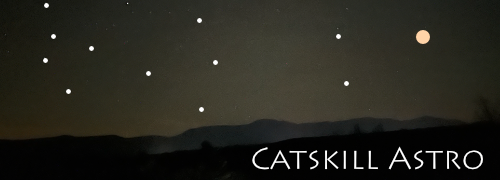Messier Objects
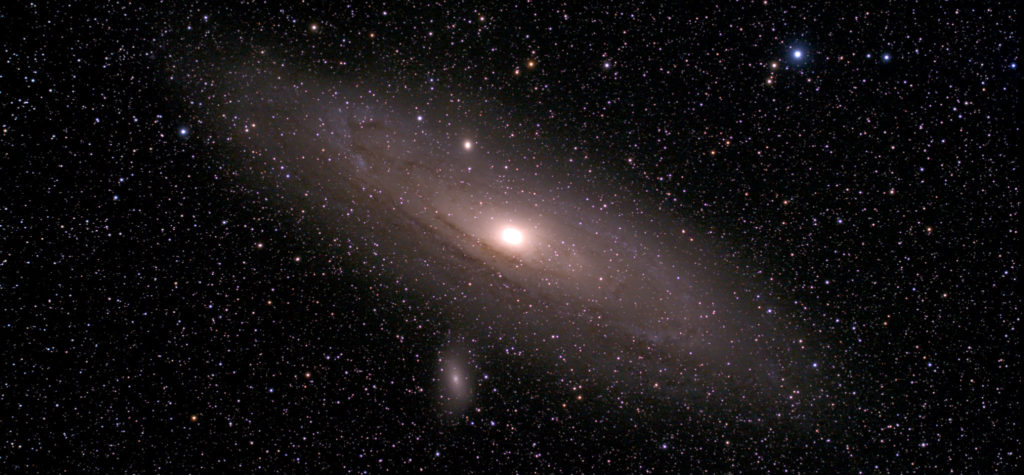
Page 11 of 11
Messier observations 101-110 of 110 total to date.
| Catalog # | Thumbnail | Title/link | Description |
|---|---|---|---|
| M101 | 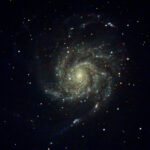 |
Arp 26 / M101 / Pinwheel Galaxy | This is a Méchain discovery dated March 27, 1781. No formal recording date is noted for M101 nor for any remaining entries in the Catalog: "Nebula without star, very obscure & pretty large, of 6 or 7 minutes [of arc] in diameter, between the left hand of Bootes & the tail of the great Bear [Ursa Major]. It is difficult to distinguish when one lights the [graticule] wires." Halton Arp selected M101 for his Atlas of Peculiar Galaxies based on "one heavy arm" <--> This is a favorite target to which I've returned many times. Featured image is a recent capture with my new ASI2600mc-pro camera, my first outing with that camera and the EdgeHD. This was the same night as my recent capture of M81, but transparency had worsened. Fourth image in the gallery was a July 2023 observation (compared to yet another recent one) to show supernova SN 2023ixf, which had been discovered on May 13, 2023. |
| M102 | 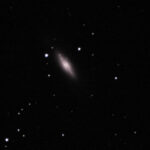 |
M102 / NGC 5866 / Spindle Galaxy | Undated entry by Méchain from late March or early April, 1781: "Nebula between the stars Omicron of Bootes & Iota of the Dragon [Draco]: it is very faint; near it is a star of the sixth magnitude." The entry was published without confirmation and without a measurement, although Messier's personal copy of the Catalog contains a handwritten location. Méchain disclaimed this observation in a letter to Bernoulli, written May 6, 1783, and declared it was an erroneous re-observation of M101. However, Messier's location and the description both point to NGC 5866 as the likely target. <--> This is an edge-on lenticular galaxy with a well defined dust lane bisecting the disk. Deserves more than 10m but cut short by clouds. Originally imaged by me as part of the CN EAA Challenge for September '23. |
| M103 | 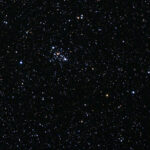 |
M103 / NGC 581 | Undated entry by Méchain: "Cluster of stars between Epsilon & Delta of the leg of Cassiopeia". As with 102, in the rush to publication, it was neither reconfirmed nor measured. M103 was the highest-numbered catalog listing published during Messier's lifetime. M104-110 were added by later astronomers based on observing notes and writings that showed Messier or his assistant, Méchain had observed them after the last publication date of their catalog.<--> This is a small, attractive open cluster in Cassiopeia, nestled in an interesting star field mottled by dark nebulae. I observed this as part of Dec 2023 Cloudy Nights EAA challenge. |
| M104 | 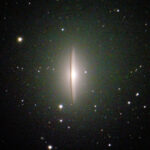 |
M104 / Sombrero Galaxy / NGC 4594 | M104 is numerically the first object now accepted as a Messier object which was not included in Messier's final-published catalog. However, Charles Messier added it by hand to his personal copy on May 11, 1781, and described it as a "very faint nebula". Méchain, in a letter to Bernoulli, May 6, 1783, claimed discovery on May 11, 1781. <--> What can you say? This is a bizarre target to observe.... it is a nearly featureless galaxy of uncertain classification, viewed side-on, distinguished by a pronounced central bulge (the sombrero's crown) and by a narrow, highly-defined dust band around the periphery of the disc. Older sources classify it as a spiral galaxy. More recent observations by the Spitzer and Hubble space telescopes have found the bulge larger than originally indicated, and now classify it as a giant elliptical galaxy. |
| M105 |  |
M105 / NGC 3379 | M104 was added to the Catalog based on Méchain's correspondence in his letter to Bernoulli, May 6, 1783: "There is, however, a third [nebula], somewhat more northerly, which is even more vivid [brighter] than the two preceding ones [M95 and M96]. I discovered this one on March 24, 1781, 4 or 5 days after I had found the other two." <--> I observed M104 on a crazy night when this was the only target I could sneak in before the clouds closed in. As a bright, elliptical galaxy this was the perfect target for a brief observation.... While longer integration would have enlarged the size the disc "halo" it would not have added structural details. |
| M106 | 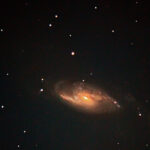 |
M106 / NGC 4258 | Méchain in his letter to Bernoulli, May 6, 1783: "In July 1781 I found another nebula close to the Great Bear [Ursa Major] near the star No. 3 of the Hunting Dogs [Canes Venatici] and 1 deg more south, I estimate its right ascension 181d 40' and its northern declination about 49d. I will be going to determine the more accurate position of this one shortly." <--> I was anxious to test my brand new 2600 on the EdgeHD. This was intended to be one of several captures this night, but it turned into the only useful one because of the 93% moon, and a thin layer of high clouds became increasingly irksome as the moon rose higher. This is a 3/4 view of a bright, disrupted, spiral disk. First the bright galactic nucleus is offset towards the near (bottom) edge of the bulge. Normally it should be centered. There are two major arms visible -- which is typical -- but they are far from symmetrical. The one of the left wraps 180° of arc around a semi-circular section of the bulge where most of the mass seems to have been evacuated. The arm on the right is connected to what appears to be the majority of mass in the bulge. But it curves through only 90° of arc, covering only the far side, and brings the right end of the disk to a point. |
| M107 | 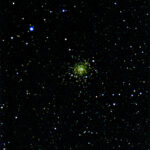 |
M107 / Crucifix Cluster / NGC 6171 | Méchain's letter to Bernoulli, May 6, 1783 triggered the addition of M107 to the list: "In April 1782 I discovered a small nebula in the left flank of Ophiuchus between the stars Zeta and Phi, the position of which I have not yet observed any closer." <--> Ranked 16 and 25 respectively among all Messier GCs for brightness an size. This was an opportunistic capture on an evening when the weather forecast suggested no observing would be possible. A loose globular cluster that vaguely resembles a Celtic cross, particular if rotated 180° from the current rotation. This seems like "cheating" since part of the cross seems to depend on two, bright field stars that extend the line of the cross, and appear most likely unrelated to the cluster. The third image in the gallery is a recent capture using the Askar V and 2600mc camera (rotated roughly 90° counter-clockwise from the Seestar image). In this capture, it's obvious the the cluster is situated in a field mottled with dark nebulae, |
| M108 | 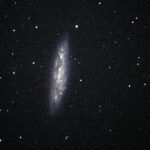 |
M108 / Surfboard Galaxy / NGC 3556 | The Catalog's description of M97 mentions a "Nebula near [M97 and Beta UMa], [position] yet to be determined." Méchain claimed discovery in his famous May 6, 1783 letter to Bernoulli. Messier added a position by hand on his personal Catalog which was identified by Owen Gingerich in 1953 as NGC 3556. Hence, M108 was added to the catalog. <--> This is an attractive spiral viewed nearly side-on. The spiral is somewhat elongated, so the combination of the pointed ends and the foreshortening from our angle of view makes it appear like a surfboard. |
| M109 | 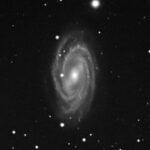 |
M109 / NGC 3992 | Messier added a position by hand to his personal copy of the catalog which was identified by Owen Gingerich in 1953 as that of H IV.61 = NGC 3992, which is now called M109. Messier thought he was confirming Méchain's discovery, but Méchain almost certainly saw NGC 3953, converting this to Messier's personal discovery (#43). <--> Latest observation was on a recent, better than average night. You'll find an earlier capture in the gallery from March of 2024 that was cut short by clouds and heavily processed. Both captures reveal a classic "theta" style barred spiral galaxy, though the more recent capture shows a lot more detail in the spiral arms due to the improved sensitivity of the mono camera and longer integration (40m not 12m). |
| M110 | 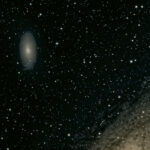 |
M110 / NGC 205 | This galaxy was discovered by Charles Messier (#44) on August 10, 1773. Curiously, he never recorded it in the Catalog. This was the last additional Catalog entry, added finally by Kenneth Glyn Jones in 1966. <--> I've imaged M31 many times, and all include a view of M110. This image, taken with my Evo 9.25 remains my favorite depiction of M110 despite its obvious flaws. I just love the way this dwarf elliptical galaxy is floating freely in the foreground while Andromeda looms below. At the time, this was my only focal length option and I could image only a small fraction of M31. This framing struck me as an elegant solution at the time, and still does. |
